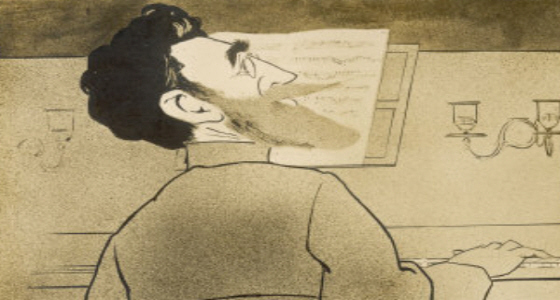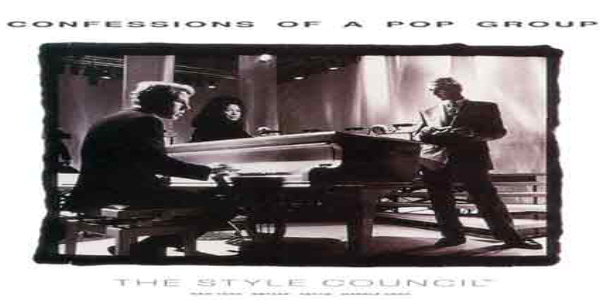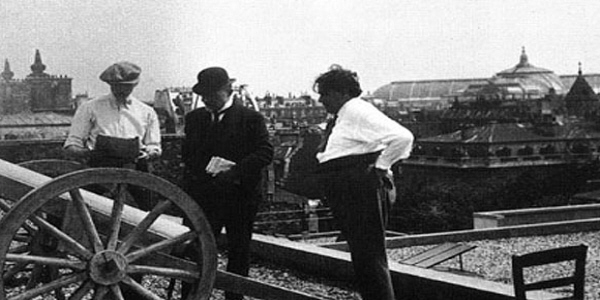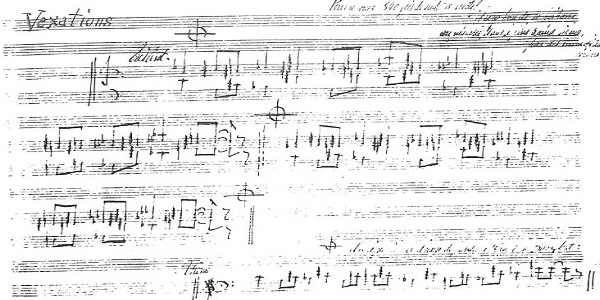
Never underestimate the power of music. It can elevate you to great heights; and yet it can take you down further than you’ve ever known. It can inspire greatness, but can also provoke intense sadness, so never, never think light of its power. Look what it did for me…
Weaned on The Jam, Pistols and music so crudely raucous, I never thought as a 15-year-old punk rocker I would be solicited by any sort of classical music. How wrong I was. Indeed, how narrow minded was I to think the genre may have even thrown up its own rebel within its stuffy corridors.
Erik Satie was a 19th century French composer who as my impeccable researchers have proven, was a mischievous punk of the highest order. OK, while he wasn’t firing at exactly the same targets most modern musos shoot at, he still managed to affront the establishment with his strange antics and bizarre behaviour.
However, it wasn’t just this craziness that set him aside from his peers. Underpinning all of this malarkey is music so extraordinary, it’s impossible to classify or pigeon hole. Deep, mesmerising, penetrative, beautiful, I have given up searching for adjectives to describe Satie’s spine-tingling sonics. Without sounding too intoxicated, all I can say is that Erik Satie has had more effect on me than any other musician, living or dead. While most certainly, I would have more than a few Beatles, Beach Boys, and XTC records in my desert island rack, if push came to shove I’d happily send the lot into the wild blue yonder if just to hold onto one slab of vinyl. And that would be Erik Satie.
Actually, you may well have heard Satie without realising it. Most likely it would be the first part of his most popular piece, Trio Gymnopédies. It’s a simple, yet deeply soul-penetrating composition that resonates on a extraordinarily deep level. Its metre is simple; its theme intriguing, and at just a few minutes long, its one of classical music’s shortest pieces. While no one knew it at the time, Satie had originated the first ambient pop song. A true genius, clearly light years ahead of his time, the Frenchman was clearly aiming well beyond the stars.
I am not alone in my appreciation for this man. David Sylvian effectively re-wrote Gymnopédies for Japan’s hugely popular single, Nightporter. Paul Weller incorporated a lot of Satie’s atmosphere for the Style Council’s remarkable Confessions Of A Pop Group album in 1989. Others such as John Cage, Phillip Glass, Kate Bush, and even Gary Numan have sampled Satie’s ambient and minimalist music for their projects. Others, not necessarily from musical spheres, have waxed lyrical about Satie’s remarkable body of work and his ability to charm the unsuspecting.

So who is largely unsung individual whose influence knows no boundaries? Born in Honfleur, northern France in 1866, the Satie family moved to Paris when Erik was just four. It was in the French capital that the youngster begun his love affair with the piano. Inspired by his father’s work as a composer for cabaret and theatre, Erik’s primary talent elevated him to the highly respected Paris Conservatoire at the tender age of fifteen. Even at this early stage, Satie’s bohemian and unorthodox side was stating to manifest itself. Labelled, “insignificant and laborious” by one of tutors, and “the laziest student in the Conservatoire” by another, Satie was clearly setting out his own highly idiosyncratic path.
Refusing to be labelled by something as limited as a “musician”, Satie would begin to call himself a "phonometrician"; a term he coined for someone who measures sounds. While he would intrigue his peers with his unconventional compositions, he would simultaneously enrage the rigid quarters of musical academia with his anarchistic approach to authority. Predictably as a result of his off-beat approach, Satie would be suspended from his studies at the Conservatoire and exiled to a tiny flat he rented in Montmartre.
To supplement his income, Satie would tinkle the ivories in the district’s famed Chat Noir café as well as taking commissions for any mediums that required a musical backdrop. It was in this hugely creative period that he’d write what would be his most popular composition; Gymnopédies. Inspired by a Greek dance, the nakedly simple, yet mournfulness of the piece would enchant all who heard it.
It was during this period that two luminaries of the classical world, Claude Debussy and Maurice Ravel, became enchanted by Satie’s extraordinary work. As a result, the pair would begin to imbue their own compositions with his understated and ethereal style of composing. While Debussy and Ravel would see their celebrity rise within their respective lifetimes, Satie continued his meagre existence, living in virtual poverty. This was no hinder his prolific output, and he’d dedicate his days composing great reams of pieces, some accessible, others pushing the boundaries of the classical music to totally unexplored realms.

With rents spiralling in Montmartre, Satie was forced to find cheaper lodging in Arcueil, a suburb some 4 miles from the centre of Paris. Largely alone and ensconced in his flat overlooking a small school, Satie would find his muse propelled in newer and even stranger directions.
As well as his own work, he would undertake any other genre that paid. Nonetheless, he would ensure these compositions would retain his idiosyncratic presence, if just for their titles. With pieces such as Veritable Flabby Preludes (for a Dog), Mona Lisa's Moustache, Sketches And Exasperations of A Big Boob Made Of Wood, and Desiccated Embryos, it was clear that the mischievous composer was out to affront as many conventions as possible.
No tenant of the Classical music world would be left unturned by Satie’s scandalous affront to convention. Whereas sheet music instructions to the pianist or conductor of the period would be typically cold and prescribed, Satie’s irreverence would ensure instructions such as "Light as an egg", "Open your head" or even "Work it out yourself", be applied to his work. Adding a unique stamp to these manuscripts, all of Satie’s notations and instructions would be written in red ink.
It wasn’t just the titles or instructions that would perplex its listeners. On the face of it, Satie's Vexations was a short and largely uneventful piece. Adding some comical if absurd humour, Erik wrote “To be repeated 840 times" as an instruction, ensuring that anyone dutifully replicating the work would have to spend 19 hours at the piano.
With his compositions splintering off in numerous tangents, Satie’s behaviour became even more bizarre. In a period when genres were rigid, Satie and a small band of anarchic collaborators developed “Furniture Music” as a comical antidote to stern disciplines of the day. The earliest known precursor of ambient music, Satie and co. was seen performing this unique composition at the opening night of a Parisian gallery. The event was hugely significant as was Satie’s behaviour, imploring the guests to ignore what they were hearing.
While this surreal anarchism would fascinate his small circle of admirers, Satie would often find himself ostracised from the stuffier quarters of the classical aristocracy, and as a result, work would be slim. In an act that would no doubt please several of today’s precious rock stars, he’d also publish his own magazine, writing articles condemning some of the more loftier critics of the day, many of whom who’d been happy to condemn Satie’s body of work. While a member of the largely esoteric Rosicrucianism movement, he’d later establish his own church named the Metropolitan Church of Art of Jesus the Conductor. Typically, it only had one card carrying member.

With a trickle of work still continuing in central Paris, Satie would traipse the five miles into town and then perform the same trip on the way back. Paris being slightly less gentile than it is these days, the musician carried a hammer to protect him from some of the rougher suburbs he was walking through.
However, these daily travels would take their toll, as would his heavy consumption of cheap red wine. Assuming a reclusive status, he’d take to hiding away for the majority of daylight hours. His eating habits were in keeping with his bizarre lifestyle. "My only nourishment consists of food that is white,” he revealed in a self-penned booklet, listing his preferred menu as “the fat of dead animals, veal, salt, coconuts, chicken cooked in white water, mouldy fruit, rice, turnips, sausages in camphor, pastry, cheese (white varieties), cotton salad, and certain kinds of fish (without their skin). I boil my wine and drink it cold mixed with the juice of the Fuchsia. I have a good appetite, but never talk when eating for fear of strangling myself.”
Nonetheless, Satie’s simmering influence would continue to grow, helped by the patronage of his old friend Claude Debussy. Attracting a cult following among Paris’ left-field community, Satie started to garner a modicum of fame that had eluded him for most of his life. With canonisation by an anarchic group known “Le Six”, Satie would prove an inspiration for those seeking to escape the rigidness of conventional music. This canonisation was preserved by Satie’s one and only appearance on film a year before his death. His cameo in Rene Clair’s short Entracte, saw the elderly revolutionary in typically bizarre stance, bouncing up and down on a Parisian rooftop, omnipresent umbrella in hand.
His celebrity would also bring him into contact with two luminaries of the Cubist movement; Jean Cocteau and Pablo Picasso, and he’d work with the pair on a number of projects. Satie’s final composition was the music to an off-beat ballet entitled Relache. Totally in keeping with his unpredictable persona, a grinning Satie was driven around the stage in a tiny Citroen car at the end of Relache’s premier, managing once again, to enrage the establishment he so despised.
With his drinking consuming most of his energy, Satie died from cirrhosis of the liver on 1 July 1925. His small band of appreciators gathered in the Laplace cemetery to bid farewell to their inspirational, if slightly wacky friend. With his dwelling requiring clearing, a veritable treasure trove of the sublime and strange was discovered hiding in every pocket of his flat. Much of Satie’s legacy consisted of a raft of unpublished music and letters, much of it written to himself. Other equally idiosyncratic effects included his collection of over 100 umbrellas, and a dozen identical suits he had cut in velvet during a period when his fortunes briefly took an upturn
While Satie’s immediate influence was miniscule, he found a greater foothold as avant garde music began to escape from the closed doors of its protective coterie. Pop music has been kind to Satie over the years, as has the advertising media who find his minimalist sound in such pieces as Gymnopédies and Gnossiennes suitably ambient to sell their objects to the masses. Ironically, you’re likely to hear Gymnopédies when you’re waiting for some multinational to answer your call. Much like Vivaldi’s Four Seasons, it has become a mainstay of call-waiting music, and as such, remains a dubious honour that Satie would probably be quite chuffed by. In the 1980’s, Gymnopédies was the theme tune for Bourneville Chocolate, awakening many (myself included) to seek out any other pieces of music the man composed. Never mind; whatever path takes you there, it’s ok. We get there in the end, even if it is via a bar of chocolate.

© Simon Wells. 2012





